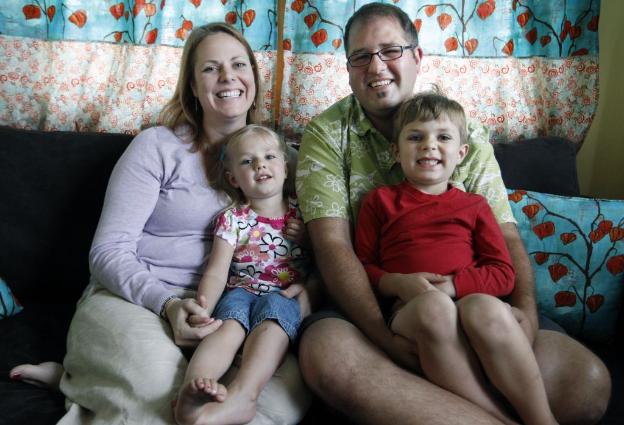At-Home Dad Cares For Family, Finances
The following is a post from Kara McGuire of the Star Tribune.


Going from two incomes to one meant getting used to a new budget, diligently tracking expenses, and accepting the trade-offs.
Linus was just a week old when Adam Nafziger decided the whole dual-income family thing just wasn’t going to work. His wife, Nicole Fitch Nafziger traveled several days most weeks selling flavors to candy manufacturers and ice cream makers. He worked long hours as a chocolatier for far less pay, and was ready for a change.
So Adam quit his job and joined the growing number of dads in America who stay home with their kids.
In 2001, there were 81,000 stay-at-home dads, according to the Census Bureau. Last year, there were 154,000, a 90 percent increase.
To be sure, some of this growth is related to today’s tough job market. But many dads have decided that they want to play a more active role in childrearing than their dads did when they were kids.
Almost five years later, Adam is still the primary caregiver for Linus and 2-year-old Freya. He’s also the family chief financial officer and is in charge of the household budget. Here’s how the Nafzigers transitioned from two incomes to one and how they continue to make the arrangement work:
The Nafzigers, both 35, didn’t heed the advice given by many financial advisers to craft a stay-at-home budget and stick to it in the months before Baby. There were just a few weeks between the day Adam declared he was going to stay home to the day he handed in his office keys. However, they were used to living mostly on Nicole’s $75,000 salary and using his earnings and her bonuses to save and pay for life’s extras.
Looking back, the Nafzigers realize it would have been smart to enact a trial run, living on her salary exclusively to see what it would feel like, and suggest couples considering the shift from two incomes to one try it out first.
They did analyze how their expenses would change. A back of the envelope calculation revealed the painful truth that two-thirds of Adam’s salary would go to pay for child care. They also realized that having him home would mean spending less money on prepared foods and the other conveniences that dual-income families often rely on.
Before making a final decision, families should examine their expenses using an at-home scenario and an at-work one, including how their tax circumstances would change. Most tax software programs have a tool for estimating next year’s taxes. IRS.gov also has a handy tax withholding calculator.
Adam is a Quicken super-user, tracking the family expenses with the online personal finance tool. He got serious about the program ever since fessing up about his credit card debt early in the relationship, and Nicole insisted on crafting a plan to become debt-free. Today, it’s Adam who tracks the family’s spending and saving to the penny using household budget software. But he sends his wife an e-mail every Friday with a financial update. Nicole also stays involved by double-checking Adam’s accounting monthly.
Quicken isn’t the only option for tracking expenses. Banks are also beefing up their online budgeting tools, or an old-fashioned notebook can do the trick.
The Nafzigers use Quicken to keep track of what Nicole describes as “a ridiculous number of savings accounts,” designed to make sure they have cash on hand to pay for everything. Living on a single income means less wiggle room for irregular expenses. Each child has a savings account for their clothes and activities. Then there is the vacation account, the rainy day fund, the car expense fund, and the everyday spending account for groceries and the like. Both Nicole and Adam get a small allowance too, so Adam can treat himself to a good bottle of gin for martinis, and Nicole can buy knitting supplies. But they’re never secretive about where it goes.
In all, they have 14 accounts, and are very strict about not transferring funds from, say, the car fund to the vacation fund if they find themselves short.
Being open about finances is a key part of their success story, even with friends. “Unless you have some kind of transparency, it’s hard to do things” with friends, whose incomes are “all over the map,” Adam explained.
Nicole never uses the fact that she is the breadwinner to wield more power over financial decisions. “That attitude of ‘It’s my money, I earned it’ just has to go straight out the window,” she said. “It’s our money and our family and we decide how to spend it.”
They also acknowledge the price tag on Adam’s role at home. Add up the cost of child care, cooking, cleaning and other household chores he does, and it’s clear that it would cost a lot to outsource these services if he passed away. So Adam has a life insurance policy. Nicole does too. What she doesn’t have is a long-term disability policy. That’s next on the financial to-do list.
The couple accepts that Adam’s decision to leave the workforce will affect their finances down the road too. They haven’t been able to save nearly as much for retirement as they did before Adam quit his job. He’s grateful for compound interest, and the fact that they saved diligently early in their careers. “We are probably more ahead of the game by putting away money in our twenties,” he said.
They also hope the Minneapolis starter home that they turned into a rental property after moving to a bigger house will help pay for college.
Adam doesn’t plan to go back to work anytime soon and knows his earning power may be permanently reduced by staying home. But the pair is content with their decision.
“Maybe it’s more important to live well now and raise our kids well now than to have this goal of living footloose and fancy free at 65,” Nicole said.
Quicken has made the material on this blog available for informational purposes only. Use of this website constitutes agreement to our Terms of Use and Privacy Policy. Quicken does not offer advisory or brokerage services, does not recommend the purchase or sale of any particular securities or other investments, and does not offer tax advice. For any such advice, please consult a professional.


